In a world of endless social media noise, virality isn’t about luck – it’s about science. My guest on today’s show, Brendan Kane, is the author of One Million Followers, Hook Point, and The Guide to Going Viral. Brendan brings nearly two decades of experience transforming brands and individuals into digital powerhouses, generating over 60 billion views and helping clients build audiences of 100+ million followers.
A master of data-driven content strategy, Brendan works with global brands like Mindvalley and Fortune 500 companies to crack the code of online engagement. His innovative approach breaks down exactly what makes content spread. Through testing and analysis, he identifies the hook points and story structures that grab attention instantly.
In our conversation, we explore the science behind viral marketing, diving into specific formats and frameworks that drive results. Brendan shares fascinating case studies of everyday creators who’ve built massive followings by understanding key performance drivers. He breaks down exactly why certain videos get 10,000 views while others reach 10 million, revealing the subtle differences that make content truly compelling.
Whether you’re starting from zero or looking to scale your existing audience, you’ll discover proven strategies to transform your social media presence and build a powerful digital brand that stands out in today’s attention economy. So, without any further ado, on with the show!
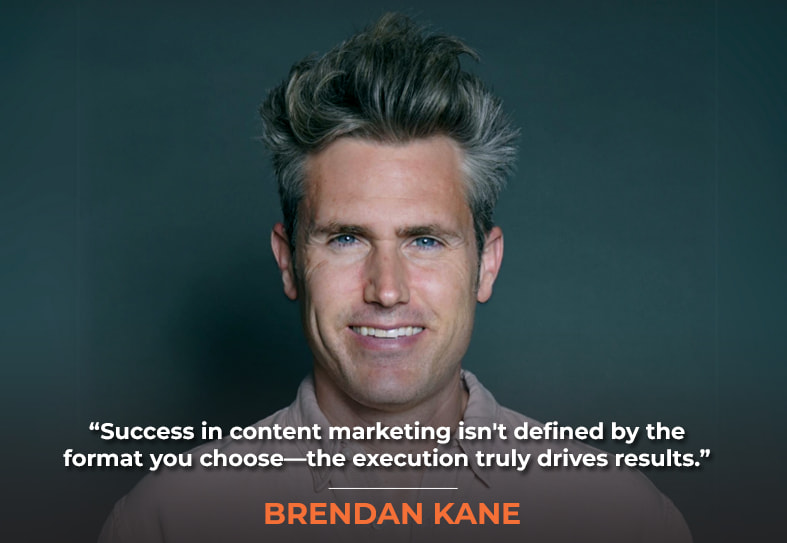
In This Episode
- [03:18] – Dive into a real-life example of how Brendan Kane transformed the educational platform Mindvalley into a digital powerhouse through creative restructuring.
- [09:22] – Understand how integrating educational topics such as AI and social media mastery aligns with Mindvalley’s broader mission and appeals to its audience.
- [17:57] – Explore social media monetization, from ad revenue to billion-dollar empires, and how Brendan’s agency uses partnerships and revenue sharing for success.
- [22:49] – Discover how Brendan’s methodologies enable even those on a shoestring budget to achieve social media success.
- [25:05] – Find out how Brendan’s books, including Hook Point and The Guide to Going Viral, serve as strategic tools for broadening reach.
- [32:35] – Unpack why major platforms like YouTube and Facebook aren’t going away despite new competition and tech shifts.
- [35:42] – Get a sense of Hook Point’s fee structure and how they tailor their services to different organizational needs.
- [37:01] – Discover key performance indicators (KPIs) for measuring and improving social media success.
- [40:26] – Brendan outlines his five-step framework for creating viral content, starting with comprehensive ecosystem research.
- [45:07] – Discover the nuances of tweaking and re-uploading social media content to improve performance.
Brendan, it’s so great to have you back on the show.
Yeah, thanks for having me. It’s a pleasure connecting with you and anybody tuning into this.
Yeah. So, I’d love to start with a real case study example. I know you worked with Mindvalley and have some great testimonial quotes from them. I’d love to unpack a bit about how that has been able to turn into a digital powerhouse. I think they’ve said somewhere that you’re their secret weapon. So, suppose you could talk a bit about it without revealing anything confidential. What secret sauce is behind making a brand like Mindvalley a digital powerhouse in viral marketing?
So Mindvalley, even before I worked with them, they were a household name in the education space and doing well and doing pretty well on social media. And over the past, I would say we’ve been building a creative model for six or seven years. I mean, I kind of started building a version of it when I first started in social media. 2005 and 2006, but it is really kind of dialing in the model and process by which you actually create content, analyze content, and understand what content to create and what content to avoid creating.
Context beats content.
That’s what we did with Mindvalleys. They had a really smart team working on their social media efforts, and we came in and just restructured the creative model and process they used as they were going through the content. Our team’s done about 10,000 hours of research into understanding how and why things go viral. And really, it’s more about the context of how you deliver your message and your information than the actual content itself.
So when you think about somebody like Mindvalley, it’s not that we change the content and what they spoke about, but more about how they packaged it to break through in this world that we live in where there are close to 5 billion people on social media.
Let’s dive into how they were able to do that; for example, if you had any part in this, their AI Mastery course, which is pricey, like $10,000. To my knowledge, they weren’t offering an AI before this. This was relatively new in the last couple of years. I did sign up for it, so I’ve seen the value of that amazing course. I don’t know if you had any involvement in getting the word out about that, but I don’t know.
It was really successful having a three-day free masterclass that people could attend, and then that led to the nine-month long course program, and I think they had on at least that three-day event, at least 10,000 people or some crazy number like that, live attending a webinar. That’s pretty impressive. So, is that something that you were involved in, getting that kind of reach and engagement?
We had limited involvement in that one. We were a big part of the Social Media Mastery program and will do another one with them in May. However, we can look at AI as an example of how to approach it. What we’re talking about is typical: if you talk about AI as AI in general, it will attract a specific audience, and many people will zone out or become essentially uninterested in the subject because it seems too technical.
So, how do you take AI and make it applicable and interesting to the widest possible audience? Mindvalley did a great job with that, and they leaned into the fact that AI is not going to take your job; it’s people who are learning AI who will take your job.
AI will not take your job; people learning AI will take your job.
So automatically, even if you’re not interested in technology or artificial intelligence as a technology platform, you are interested in the applications of how it can impact your everyday life. And that’s one of the big aspects of what we talk about with social media is called the generalist principle. It is how you take your subject matter and your expertise and not just make it interesting to your core audience, your niche audience, which you want to do, but how do you also broaden it out and allow it to connect with somebody that may not be thinking about that subject matter, may glance over it if somebody else is posting about it or just generally just not have interest in it? How can you flip it on its head so people will stop and pay attention and be like, “Oh, this is something I want to learn; this is something I want to spend a three-day seminar in because it impacts me or it interests me in terms of the way that they’ve contextually packaged it for the wider audience.”
Gotcha. And so when they came to you to be involved in the Social Media Mastery program, which includes the three-day event, but also that eight or nine-month program or whatever, what was the benefit or the pitch to you, and what did they get? What did you get? How did you protect your IP and not just give it away for free to them, but they got what they needed out of it?
Yeah, so there’s a few different layers to that. I mean, I’ve known Vishen since 2017. So, I have a long-standing relationship with Vishen and Mindvalley, and I have consulted through Hook Point with his personal and Mindvalley brands over the years. He wrote the foreword for my second book. So there’s a long-standing relationship there regarding why I do it. Obviously, there’s a revenue upside because we participate in the program’s success and in terms of protecting our rights and things, we’re pretty good because we’ve invested a lot in our intellectual property. I understand I’ve filed patents, applications, and things back as early as 2006 and 2007. So I’m pretty familiar with intellectual property, how you protect that property, and make sure it’s still a win-win for both sides.
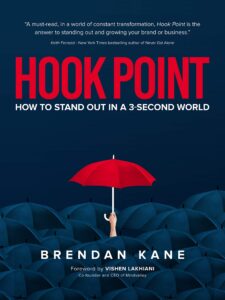
But in terms of the benefit, there’s the revenue upside and there’s the exposure upside. Mindvalley is a big platform where you can get exposure to a new audience. I’ve always resonated with the Mindvalley community over years of speaking with them and connecting with them at their events. And my whole mission is really to help as many people as possible breakthrough with their message so that they can have the impact that they deserve and believe in.
So, are Social Media Mastery and AI Mastery too far afield for spirituality and personal development platforms like Mindvalley? Is that spreading their brand too thin or kind of going off-message?
I don’t think so. I think that spirituality, mindset, and what they talk about are part of the education ecosystem. Mindvalley is an education company that has really mastered the art of teaching spirituality and mindset. And the next logical step is to expand beyond that. With that said, there are a lot of people in that community that can benefit from AI Mastery. They can benefit from social media because a lot of people in that community are solopreneurs, entrepreneurs, yoga teachers, meditation instructors, coaches, and things of that nature. Obviously, as the world evolves and expands, they’re willing to integrate AI into their skill set, organization, and strategy. And the same thing with social media.
So, those programs are doing so well because they are easy to cross. After all, it provides a lot of value to that audience and allows them to introduce the Mindvalley brand to new audiences, bringing them in to learn those elements.
Let’s actually move from Mindvalley to another client of yours, which I was checking out in preparation for our interview. This is a former NFL player who is now into woodworking, John Malecki. So he has a great testimonial about you and working with your agency, Hook Point. I was impressed with his channel on YouTube, its approach, style of videos and everything. So maybe we could deconstruct how you helped him change his approach, style, points, and everything else. Maybe use a representative video of him before working together and then one after and just deconstruct it for our listener or viewer.
Yeah. So again, as we were talking about with Mindvalley, I think one of the big elements of success, or lack thereof as it pertains to organic social media is really how do you take your zone of genius, how do you take your expertise and again, make it interesting to the core audience you’re going after, but also broadening that out. So, one of the specific exercises we do with our clients that our model is built on is understanding specific formats and structures that have proven successful across social media. So our team, as I mentioned, has done about 10,000 hours of research. We’ve broken down about 220 of these different formats.
So I want to kind of just paint the picture that there are a lot of them out there, but there are specific platforms that work for them, or there are specific formats that work for specific platforms. When we’re looking at a client, we’re trying to determine, “Well, what is the best format that will allow them to contextualize their message and connect with a wider audience?” So, just to give you an example of a format that everybody has seen and actually was invented pre-social media, that was invented; I think late-night talk shows probably invented it, but it’s the man on the street format.
You approach random strangers on the street and interact with them somehow, and the story unfolds. So there are several different examples of that. So there is a guy based out of the UK, you’ve probably seen him, Simon Squibb, where he’s stopping people on the street, asking them what is their dream and trying to help them with advice or money to help them pursue their dream.
There’s another account called School of Hard Knocks. They’re approaching entrepreneurs on the street, asking them their business advice and how they can be successful. Then, a friend of mine worked with Alex Stemp, who amassed an audience of 20 million people using it for photography. So he approaches random strangers on the street and offers them professional photo shoots, and the story unfolds that way. So that’s an example of a proven format or structure.
Now, I just want to delineate and say that just because you’ve seen a man on the street and you understand that you approach a random stranger on the street and interact with them does not dictate success. The format doesn’t drive success. It’s the execution of that format that drives that success.
So, as we approach our qualitative analysis of something like that, what we’ll do is break down, let’s just say, the School of Hard Knocks. If we want to dissect and understand their use case, we create a spreadsheet. We take their 10 most viewed videos. There are 10 average and 10 underperformers. We’re doing a cross-analysis to understand the contextual elements that are showing up in those high performers and those that are not in those low performers.
Many aim to batch-produce content, but the risk is clear: if the first piece fails, the others will follow the same flawed model. Share on XSo, what we call them are performance drivers. So we look at things like pacing, tonality, facial expressions, body cues, what’s happening in those first three seconds, captions, title cards, hooks, all, all these different elements we’re analyzing through this format to dictate if we are to dictate and understand if we are to do this man on the street format, how are we going to actually understand what drives the performance of it?
To give a further example that people understand, I went to film school, and that’s how I started my career. When you think about making and watching movies, every movie you sit down and watch is not good. And especially if you have a favorite genre. Let’s just say that your favorite genre is sci-fi. You love sci-fi movies. Every sci-fi movie that you sit down to watch is not good. We’ve all been there, so what’s the difference? Well, it’s the casting, the dialogue, the cinematography, the lighting, and the production of all these different variables.
And the special effects, for sure.
The special effects give that format, that structure of a movie and within that subgenre, sci-fi, the ability to be successful or unsuccessful. We’re applying those same principles parallel to social media, where most people are approaching social media from the standpoint that anybody can pull out one of these. They can click, record and post something. So they expect it just to work. It’s a blessing that we have this powerful tool in our pocket. The downside is it doesn’t take a lot of thought.

So people think just because they pulled this thing out of their pocket press record and posted something, it will automatically work. So somebody, you know, going back to John Malecki, somebody like him in the beginning, you know, again, he is a former NFL player, but that’s not the reason for any of his success because most people, myself included, don’t really know John Maleckey as an NFL player unless he played for your team.
So I just want to kind of put that aside as some people think, “Oh, somebody who was an athlete or celebrity, and that’s the reason for their success.” I mean, I worked in Hollywood. I can definitively tell you a lot of actors don’t have successful social media channels. It’s not a given. So with John, again, as you mentioned, he’s a woodworker. He loves building things.
So previously, if you look at some of his content and you can look at it on the Hook Point website, we have a before and after. Is this metal rack good or awful? So, who is that going to be interested in? Well, it won’t be interesting to the general public like me. Like, I don’t really care about a metal rack. So how do you take woodworking, which is super niche, doesn’t seem super exciting or sexy or fun to watch, and turn it into something that has the potential to break through, to go viral?
Social media is a tough game to master, especially if you aim to reach the highest levels. Share on XOne of the examples we had was when I tested turning a free pallet into a $600 table, and it showed an image of him pulling a wooden tablet out of a garbage can. So that’s a challenge. How will he take this thing out of a garbage bin and turn it into a table? Is he going to be able to be successful? And how’s he going to turn it into a $600 table? The first component is this challenging aspect. Is he going to be able to do it?
The second part is kind of interesting. I would like to see if I could pull a piece of wood out of the garbage and turn it into a table. Like, there’s a clear application there. So again, it’s transitioning what we talked about before from just speaking to a niche audience to making it digestible and interesting.
And if you watch his videos, even the one where he’s taking out the pallet from the garbage and building it into a table, he’s not diluting his expertise or his skill set as a woodworker. He’s just bringing in the widest possible audience and then layering in his expertise. So, it introduces people to this brand-new world of woodworking. And it’s been massively successful in allowing him to build his audience.
Yeah. And so, what does he do to monetize that audience? How does he make this ROI positive? Because clearly, there’s a big investment there.
Yeah, I mean, there’s different ways. I don’t know the ins and outs of John’s business. We didn’t do business consulting for him, but I believe he does some courses. He can also generate ad revenue from YouTube, and then he can do sponsorship deals. But I think it’s a great question, and the reality is that when you think about ROI for social media, it’s as big as you can dream. So, I’ll give you a primary example of this: a friend of mine, Michelle Phan, was one of the original beauty influencers. Millions and millions of subscribers on YouTube. Now, there are a lot of beauty influencers on YouTube that have millions and millions of subscribers.
Most beauty influencers will do brand and sponsorship deals and make ad revenue, which can be a good six-figure-a-year business. Michelle took a different approach. She said, “You know what, I’m going to take my audience, I’m going to take my know-how, and I’m going to form a company.” And she and a few of her friends founded a company called Ipsy. That’s a billion-dollar value company. So, you could look at two people with the exact same audience size and the exact same niche. One could build a billion-dollar business. One can just do six figures a year.
ROI for social media is as big as you can dream.
So that’s why I say it’s kind of as strategic as your mind can think, as big as your mind can think in terms of how you can turn and cultivate your audience into ROI and meaningful revenue. So it’s not like a clear-cut rule book that you have a million or 100,000 followers and make X number of dollars a year. There’s no cap on what you can do with it. I mean, just look at Elon Musk, what he does with his social audience, and how he leverages it to push up the value of the companies that he’s involved with.
So I’m curious: how do you monetize? Because you’re running an agency, and you’re helping millionaires become billionaires. What about you and your leverage to create your own billion-dollar company?
Yeah. So, our primary source of revenue right now is through strategy and organization training. But now we’re at an inflection point where we have a successful and profitable business. So we’re looking at certain clients that we will participate in at a deeper level and take equity or revenue share upsides into it. There are also some industries or sectors that we’re seeing that are very underserved, that we’re going to get more involved and create subsets of our business to really go after and own a chunk of that business. So now that we have kind of the agency flowing, we have the team, we have the interest we get, and thousands of people reach out to us every month wanting to work with us. We’re at this level now where we can selectively choose certain strategic clients or partners that we can invest in. We can take the upside by ingraining our organization deeper into its marketing systems.
And so it’s not a given that it’s just because you have, let’s say, 20, 30, $50,000 to spend to hire your agency that they’re going to be able to hire you.
Yeah, I mean, we’re very selective in terms of the clients that we work with. In general, we’re even more selective if we’re taking, instead of paying our full fee, we’re taking less of a fee and more equity, or we’re investing in it. But the reality is we work with people that have the right mindset. I mean, that’s the biggest determining factor of us wanting to work with specific clients is we work with people with zero social media experience. It’s not about an experience thing. It’s not even how big your budget is. It’s not how big your team is. Do you have the right mindset going into this? Social media is a difficult game to play.
Hiring an experienced person doesn’t guarantee success if you don’t understand and oversee the project first.
For example, hook point if you want to play it at the highest level. In our organization, we really focus on how you become the top 1%. If you want to be in the top 20 or 30%, you can go and find a bunch of different people to engage or just get a regular social media manager. We’re in the business of helping people reach the top 1%, get their message to the masses and truly breakthrough. So in that, again, it’s not necessarily how big your budget is, how big your team is, your experience level, but it’s more your mindset of really going in and putting to work all the things that we bring to the table.
So what if somebody is on a low budget? Let’s say that they want to hire somebody on Upwork to do the video editing. They want to hire a different person on Upwork or Onlinejobs.ph in the Philippines to help them with script writing, video, video planning, and other stuff. Can this be done on a shoestring budget, or do you really need five, six, or seven figures to do it right?
No, you don’t. We have some clients that shoot and edit their own content. I will say that if you’re going to hire people, you need to understand first what format you’re going after. That’s one of the things that we work with clients on. There are certain formats that are much less resource intensive than other formats that are very resource intensive. So, if you’re constrained from a budget or resource perspective, it’s being really smart with the format that you select. And if you’re going to hire people on upwork or something else, you can’t rely on them to just execute at a high level. You need to understand the format and the nuances that go into it.
We help create the blueprint of it, but you need to understand it if you’re going to oversee people and hold them accountable for their performance. Because, like anything, even if you just hire an experienced person, it doesn’t mean you’re going to have success if you don’t understand it and oversee it first. We worked with, just to give you an example, a hand doctor with zero social media experience who shoots content on her iPhone, edits her own content, and she amassed an audience of 700,000 people. So, she doesn’t have a big team or an infrastructure, but she took the strategy and training we developed for her and really took that nuanced approach to understand it.
The interesting thing that we see with our clients is people who come from different backgrounds, as you can see from John Malecki, a woodworker and hand doctor. We work with a leather craftsman. People who come from backgrounds where you have to pay attention to detail to master that craft typically do really well through our programs and on social media because it is about paying attention to detail. But can you be successful in hiring somebody in India or Upwork or any of these platforms to support you? Yes, you can.

But the sheer fact of hiring them is not going to dictate your success. You need to understand the strategy, how to oversee them, and things of that nature.
And that’s where using your guide to going viral or your hook point book or both as kind of a framework or a blueprint for what to do and how to do it and when and where to allocate the budget is probably a good starting point, I would imagine.
All the stuff, the model that I was talking about, they can outline everything in The Guide To Going Viral. And for your audience, if they just go to hookpoint.com/msp to stand for your Marketing Speak Podcast. But MSP, they can download the book for free. All the details of the model are in that book. So, if you like reading books and want to dig in and give it a shot yourself, we don’t hold anything back.
Speaking of not holding anything back, I was really impressed that your second most recent book, Hook Point, is also free, and I downloaded it right from your website. What’s the monetization or ROI strategy there? If you’re giving your book away, you must have spent a lot of time and money creating and putting it out there. As it is a freely available book, you don’t even have to buy it on Amazon.
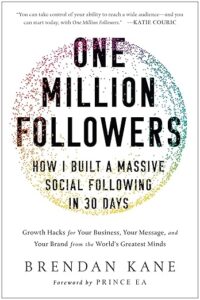
Yeah, so I create books for marketing. I don’t create books as a revenue stream. Even my first book was never about how I make money with a book, but how do I use it as a calling card or for somebody to reach out? I always wanted to build a business where I don’t have to because I’ve built businesses in the past where you have outbound sales teams, where you’re going out there and trying to go and drum up business. It was always just so expensive; I didn’t really like it. I have always wanted to build a business where inbound is coming in, with books in particular. My literary agent always said that you need to get at least 25 to 30,000 copies in the market for word of mouth to start kicking in. Now, the reality is the average published book sells less than 5,000 copies.
So rarely do you ever even get a published book that reaches that threshold to really breakthrough. So, from my perspective, because I’m not really concerned about making money off the book, I see it as a loss leader. I want to get as many copies into the market as possible.
By the way, how many books did you end up selling with One Million Followers?
I don’t know the exact numbers because international is a bit murky, but it’s in the several hundred thousand range. It could be a lot more than that. For some reason, I don’t really concern myself with it. But International, they do not give clear reporting with it on top of that, you will see a lot. Even if you don’t give away your book for free, people are going to pirate it. And that book has been pirated so many different times. And if you type in YouTube like the audiobook and things are
in there, but it’s definitely in the several hundreds of thousands of copies that have been sold thus far,
That’s a good indicator that you have several thousand ratings and reviews on Amazon for that book. That’s really cool.
Yeah, so that’s kind of the way that I approach it is I just want to get in as many copies out there, and you will see people, like, even if you give a PDF download, there’s people that will want to buy the physical book. The Guide to Going Viral Audiobook is on my YouTube channel for free. And the interesting reason I did that is because Audible is. There’s a really strange thing with Audible. So, I did my entire audiobook for this book in AI. So we trained a model, my voice. The interesting thing is Audible allows AI voice-generated books, but ACX, the company that interfaces with Audible, doesn’t. So we couldn’t get it up on Audible.
So I’m just going to give it away for free because, again, I don’t really care. I would much rather have more people listen to the book than make money off of it. Just spread it to as many people as possible. And I think over 10,000 people have already listened to the book on YouTube.
How do you get a literary agent when that’s your model? If they’re gonna make a piece on every sale and you’re like, well, I wanna give them all away, that kind of takes their motivation away, doesn’t it?
Yes and no. Again, it’s not that we don’t sell our book on Amazon; it’s not that we don’t make it available on those platforms. You will see that sales increase, word of mouth kicks in, and, again, you have to think about the fact that a percentage don’t wanna read a PDF or a big percentage will download the PDF and tell their friend you should check out this book, The Guide to Going Viral. And they don’t just say, “Oh, here’s the PDF,” that person automatically, their first thing is to go to Amazon. Like, my behavior is interesting. I don’t really read books, but I’ll buy a book. So, I have a reminder to find podcasts by the author so I can listen to them. It’s counterintuitive in a lot of ways, but it drives a massive amount of awareness and sales in the long run.
If you keep repeating the same thing without expanding your knowledge, you will never surpass the limits of your current success. Share on XBut my literary. He’s since passed away, but he was kind of a visionary in that way. But the book publishers, I can tell you definitively, don’t get it. And that’s why I self-published the past two books is like I just didn’t want to kind of go down that path of I’m a marketer at heart and I want to test things, I want to break things, and I want to just kind of push the boundaries of getting as many books out there as possible. And the publishers just don’t see it that way. And I understand it; I don’t fault them for it. They’re running a business, and they’ve been operating it in a certain way. But I just see a lot of their methodologies and philosophies as a little outdated.
And I want to pursue different avenues to push the books out there.
So you don’t have any plans to get a new literary agent, then?
No.
How did you find your first one?
It was actually through another literary agent that I knew in Hollywood that was representing screenwriters, and things of that nature made the introduction. But it was good to learn. Listen, it was a frustrating process dealing with publishers. I’ll never do it again. But you never learn until you actually do it. And honestly, if anybody listening to this is thinking about writing a book, unless they’re writing you a seven-figure advance or a high six-figure advance, they’re not going to do anything for you from a marketing standpoint. But they do make it easier in terms of cover design, getting an editor, getting it on Amazon, getting it on Audible. It’s a lot easier if you have a publisher doing it.
Long-form content will always pay larger dividends than short ones but will require much more work time and resources.
But if you can find people like you said on Upwork or things of that nature to help you put that together and you feel comfortable doing that, then I’d recommend doing it for yourself. If you have none of that infrastructure and no desire to hire anybody to help you with it, then maybe it’s a better fit to do it.
Now, you mentioned those 220 formats, including a man on the street, reaction videos and kind of documentary-style videos, et cetera. Is there a particular format that stands out for somebody like yourself who is a book author? Multiple books are a winning formula for getting your brand and books out there.
It really depends on what you’re talking about, authors; it depends on the subject matter that you’re talking about. Again, it also depends on the resources that you have available to you and the approach that you want to take. So, when I first started social media, I had very few resources. It was just me creating content. Now, I have a team. So now we’re kind of pushing the envelope. And for me, I’m investing. I’ve kind of shifted my investment in allocation from short form to long form. It’s like I spent the better part of eight or nine years investing in short-form content for my brand and kind of focusing that way.
And now we have that system dialed in. It’s a real focus for long-form if you have the time, energy, and capacity. Long-form is always going to pay larger dividends than short form. But there is a lot, again, more work time and resources that go into that.
Is there a platform besides YouTube that is a good fit for long-form? Or is YouTube really the only game in town?
It would just say YouTube, pretty much. I mean, listen, Spotify is, and iTunes has the podcast element to it, but YouTube, there’s just the amount of traffic they have; it just beats everything out.
It’s just that, you know, putting your eggs all in one basket is pretty risky.
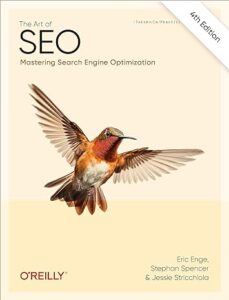
I mean, YouTube’s been around for close to 20 years. I mean, you could point to what will happen with TikTok at the time of recording this; we don’t fully understand. But listen, I’ve been doing this for so long, and people have been saying that same thing over and over again about the key players. I can’t tell you how many times since Facebook started, I have seen articles that say, “Facebook’s dying, it’s going away,” and it never does. So, I’d be slightly more cautious about startup apps or social communities. I think that YouTube is tied to Google, so it’s tied into search. Now, some people can say search is going to die because of AI.
Yes, I’ve heard that so many times. And I have that book, The Art of SEO, for which I’m known. People like to rub that in my nose, like, yeah, your industry’s about to die. What are you going to do next? And it’s like, no, it’s not. People still search.
Exactly. It’s the same thing with the big social networks now. Like, when I first started, MySpace and Friendster were the predominant players and they died. But they died because they were the first wave. They didn’t have the level of sophistication to understand human behavior or how to hook people into these platforms. User retention, monetization, YouTube, Facebook, Instagram, and TikTok have a team of behavioral scientists that are just engineering the retention into their platforms. So the core platforms now, TikTok is going through this governmental issue, but YouTube and Meta, with their platforms, are not going to face that level of scrutiny. Same with X, unless something dramatically goes wrong.
And if something dramatically goes wrong, we’ll all have to rethink social media. And at a macro level, I think that the only risk or massive shift or change in social media is what will happen with the hardware. You see Snapchat, you see Meta, you see Google, all investing in hardware. Most of that investment comes in through some form of glass. That’s where they’re kind of projecting out. But that’s at least maybe in the short term, three years before there’s a product ready to ship. It’s more likely it’s four to five years. Well, what’s the user adoption going to be like? It’s not overnight.
Retention is important because the algorithm dictates whether your content gets seen by thousands or millions of people.
Five billion people will buy a pair of these glasses and transition from a mobile device to glasses. So you’re probably looking at a five to ten-year timeframe before anything majorly disrupts. Honestly, I’m less interested in trying to predict 5 to 10 years out on social media and focusing more on what the opportunity is now because the opportunity now is still absolutely massive. And we know there’s going to be some type of crossover. Social media is not going to die, it’s just going to be how you consume that content on a different device and that consumption behavior will change eventually, but nobody knows.
Yeah, it’s an exciting time to be alive for sure.
Yeah.
So I don’t think you actually specified what it cost to hire your agency.
I mean, we have different packages. I mean, typically, it starts at 9 or 10,000, and then it goes up from there based on the scope of work. So it’s anywhere from like $10,000 to $200,000. As I mentioned, there are certain companies for which we will defer a percentage of that fee for revenue share or equity stake.
How do you arrange that? Is it tying the percentage to certain KPIs, OKRs, or milestones?
It really depends on the business. I have deal advisors who structure those deals with companies, who are far more experienced and smarter than me and are just working out what’s fair for both sides. Obviously, we want to be incentivized to help the company grow. Otherwise, our equity stake or revenue share means nothing, and we’ll never take a percentage of revenue that we didn’t earn. So, there are many different kinds of structures. But I have people who are far more experienced in how to do that than I am.
So, what KPIs would you recommend our listeners implement and track and gauge success and improve based on?
If you’re not getting views, the algorithms have deemed you’re not holding attention.
So, much of the work we do is predominantly video-based because video has a higher retention probability than image-based. Retention is so important because the algorithm dictates whether your content gets seen by a thousand people or a million people. And listen, the algorithms are very complex, technical things, but at a very macro level, they’re just designed to do one thing: keep people on the platforms longer. The longer people spend on the platforms, the more ads they serve. Thus, they’re searching for content they can see for as many people as possible and hold that attention for as long as possible.
So, one of the biggest, very simplistic things you can look at is how many views your content gets. If you’re not getting views, it’s the algorithms have deemed that you’re not holding or grabbing attention. So, on certain platforms, you can dig in a little bit deeper than that. Some of these platforms have a retention graph, meaning they can show you exactly when your audience is falling out. Is it at the 5 mark?
YouTube offers that.
YouTube? I believe that Instagram and TikTok have that as well. But you can understand where that audience is falling out so that you can get better and better at the storytelling.
You’d be surprised when you look at the graph and see 60, 70, 80% of your audience is gone in less than a minute. And it’s an hour-long video. It’s kind of devastating.
Yeah, but that’s important information to learn. Again, it’s like if you want to play at the highest level and you’re stuck at 1,000 views a video, 5,000 views, 10,000 views, that’s the reason why. And then you’ve got to sit back and understand, “Well, what am I doing differently? What am I doing differently than the top performers using the same format?” If you’re talking about podcasts, what happens in my podcast in the first 10 minutes than Joe Rogan, Stephen Bartlett or Lex Friedman or any number of the top 100 podcasts, and that’s where it becomes a storytelling Element or storytelling exercise of what are you doing differently that’s causing people to drop off?

What are you doing differently in terms of your brand, your storytelling on your long-form videos that you’ve now really focused your energies on instead of short-form?
So we’re following a listicle format that many people are following right now. We’re probably going to start testing a new format to be defined. But we study in depth the structure. Again, like we do. The same exercise that I mentioned before is that we’ll take the 10 top-performing videos in that format versus the low-performing videos. Again, we look at the contextual elements that drive success in those high performers versus those low performers. Those can be things like the pacing or the tonality. If you’re talking about YouTube, it’s a thumbnail and headline.
What does that script structure look like? What is the promise of value that’s being there? How do you pay it off in the end? When do you pay it off? As we construct those different elements, we spend about three weeks scripting a video before we even shoot it to make sure that all those elements are dialed in.
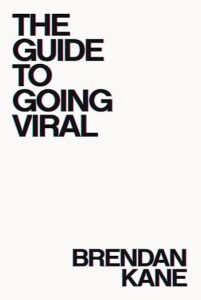
And then, as you mentioned, once we start getting data in, we’re looking at, well, what’s the click-through percentage on our thumbnail and headline? How effective is that hook that we created? From a retention standpoint, where does it seem to be falling off? And if. Is there a recurring theme of people falling off in our script structure? So that we can go back and really refine and hone that.
I know you have a five-step framework. I think it’s in Hook Point. Right?
It’s both because I just rewrote Hook Point. So, a new version of Hook Point came out a few weeks ago and is in the Guide To Going Viral.
Yep. And those five steps are?
So the first step. We’ve been talking a little bit about it, but it’s the research component. So what we’re really kind of doing is going out there and researching what’s happening in the larger social ecosystem. So, one of the biggest mistakes that people make regarding social media is just looking at their own content and their performance. And again, let’s just say you’re stuck at 10,000 views a video. If you keep doing the same thing repeatedly and not try it and learn outside of that scope, you’re never going to break through and identify what it takes to succeed at the highest levels.
In addition, TikTok kind of really introduced. This is why people will get that one video to go viral; it’ll get like a million views, but they have no idea why, so they can’t reproduce those results. So the first stop is researching, looking at the larger social media ecosystem and looking for those formats as we discussed.
And it can be as simple as changing your personal consumption behavior on social media from passive to active. So when you’re on Instagram, TikTok, YouTube, or whatever platform you use the most, you see, “Oh, that video has 10 million views. Okay, let’s click on that creator. Has that creator used that same structure at least five or six times to reproduce similar results?” And you keep doing that repeatedly until you find a format to be like, “Oh, that format’s interesting to me. I think I want to go after that format.”
One of the biggest mistakes people make regarding social media is just looking at their content and performance.
And again, it doesn’t have to be a creator doing the same subject matter. Formats like man on the street can be used for many different subjects. So, don’t pay attention necessarily to the content; rather, pay more attention to its context and structure.
So, once we’ve identified the format, we go to step two. So we select the format, and that’s where we start analyzing that specific format and creating the spreadsheet. We look at the top performers of that format, the average and the underperformers, and start trying to understand the difference between the successful and unsuccessful use cases. Once we have that understanding, the third step is ideation. Then we can come up with our ideas.
Now, most people will start with the idea phase without any idea of a structure, a format, or anything. And this is typically why that common recurring theme comes up. I have all these amazing ideas, an amazing brand, and an amazing message, but it doesn’t seem to break through.
Well, you don’t have that format or structure, that understanding of what drives that success. So once we’ve done our research, we’ve identified the format and analyzed that format, and then we come up with the ideas. And then the fourth step is called single production planning and iteration, which means we create a single piece of content at a time. Most people want to batch-produce content, but what happens with that is, let’s say we sit down and create 10 pieces of content. The first piece of content we post fails. The other nine have followed that same model. So what most people will do is they’ll just continue to post those other nine without trying to fix the underlying problem. And if you produce a single piece of content at a time, then you can move to the fifth step, which is reviewing the results.
And with our model, let’s say the video doesn’t work well. Our model accounts for this and doesn’t allow this opportunity loss to happen. Which means if your content follows, you produce a piece of content following this model. It fails to break through, well, what you can simply do is put your video on one side of the screen and then pull up one of those high performers on the other side of the screen and play them side by side and just understand, “well, what did I miss? Did I just not execute something properly, or did I miss something in that high performer?” Maybe I thought that it was really the hook that was driving it, but it was really the tonality that was driving it, and I just missed that, and I’m going to go fix it the next time around. Or maybe I thought I was doing the pacing correctly, but I was off like my pacing was way too fast. I lost people in it.
But if you follow that exercise of putting your piece of content against the high performer, and oftentimes we recommend doing that before you even post it, you will learn where you kind of fell off. In addition, if your video did break through, now you understand, “Okay, I followed this model, I followed this process, I understood the things that I needed to integrate to make this format work. Now I know it works, so I will go do it again.” So you have that fundamental learning and understanding built in.
If you keep doing the same thing repeatedly, do not try it, and learn outside of that scope, you’ll never break through and identify what it takes to succeed at the highest levels.
Can you take a video that you kind of misfired on, delete it and then make the tweak and then republish it, or once it’s out in the wild, you’re kind of done, you have to start over with a new one?
No, you can. YouTube is a little bit more difficult. YouTube has a built-in tool allowing you to cut pieces out of a video. So if there is something that you saw that just is killing the retention, you can cut it out. In addition, for the thumbnail, you can A/B test and always integrate and introduce new thumbnails into it. The short form is a little bit easier in terms of what you’re talking about, taking it down, cutting it, and re-uploading it. YouTube, I think that they’re a little bit more aware of it, and they would rather you test these elements first before you go to that level. But yes, you can.
If it’s a really small change, you’re like, if I just did this, I think it would perform, then yes. But if it’s a full restructuring of the piece of content, you just have to kind of look at it and determine if it is better to create this from scratch with this learning, depending on the amount of time, energy and resources it took to do it.
Well, this has been fascinating. I know we’re up on time. If our listener wants to get your latest book again, we want to give that special URL out.
Yeah, it’s hookpoint.com/msp. M as in Mary, S as in Sam, and P as in Peter.
Then, if they wanted to hire your agency, it’s just hookpoint.com. And then, where’s your favorite social platform to send people to follow you and be amazed by what you’re publishing?
I think it would be good for people to check out my Instagram channel because I do a lot of these quick breakdowns of what’s the difference between a video similar, same creator, very similar nature, that generated like 100,000 views versus 10 million views there? Those videos are typically less than 60 seconds.
Those are great, by the way. I’ve seen a number of them.
Oh, thank you. Yeah, so that can be at a very macro level. They can dive in super quickly and understand a little more about what we’ve discussed today. Then, on LinkedIn, I have a newsletter that we release every week, so they can connect there.
Yeah, awesome. I recently subscribed. All right, well, thank you so much, Brendan. This was fabulous. Thank you. Listener, please do something with this. This isn’t just edutainment.
This is for your betterment and the betterment of the world. So, apply it to your business, your marketing, and make the world a better place. We’ll catch you on the next episode. I’m your host, Stephan Spencer, signing off.
Important Links
Connect with Brendan Kane
Apps/Tools
Books
Businesses/Organizations
People
Previous Marketing Speak Episode
YouTube Videos
Your Checklist of Actions to Take










About Brendan Kane
 With nearly two decades of experience, Brendan Kane has transformed brands, influencers, and individuals into digital powerhouses. His data-driven approach and innovative content models have generated 60 billion views and 100+ million followers.
With nearly two decades of experience, Brendan Kane has transformed brands, influencers, and individuals into digital powerhouses. His data-driven approach and innovative content models have generated 60 billion views and 100+ million followers.







Leave a Reply